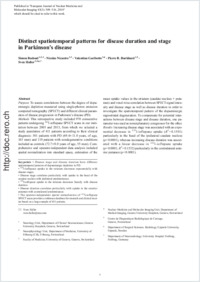Distinct spatiotemporal patterns for disease duration and stage in Parkinson’s disease
- Badoud, Simon Neurology Unit, Department of Clinical Neurosciences, University Hospitals, Geneva, Switzerland - Neurophysiology Unit, Department of Medicine, University of Fribourg, Switzerland - Faculty of Medicine, University of Geneva, Switzerland
- Nicastro, Nicolas Neurology Unit, Department of Clinical Neurosciences, University Hospitals, Geneva, Switzerland - Faculty of Medicine, University of Geneva, Switzerland
- Garibotto, Valentina Faculty of Medicine, University of Geneva, Switzerland - Nuclear Medicine and Molecular Imaging Unit, Department of Medical Imaging, University Hospitals, Geneva, Switzerland
- Burkhard, Pierre R. Neurology Unit, Department of Clinical Neurosciences, University Hospitals, Geneva, Switzerland - Faculty of Medicine, University of Geneva, Switzerland
- Haller, Sven Faculty of Medicine, University of Geneva, Switzerland - Centre de Diagnostique Radiologique de Carouge, Geneva, Switzerland - Department of Surgical Sciences, Radiology, Uppsala University, Sweden
-
29.08.2015
Published in:
- European Journal of Nuclear Medicine and Molecular Imaging. - 2016, vol. 43, no. 3, p. 509–516
English
Purpose: To assess correlations between the degree of dopaminergic depletion measured using single-photon emission computed tomography (SPECT) and different clinical parameters of disease progression in Parkinson’s disease (PD).Methods: This retrospective study included 970 consecutive patients undergoing ¹²³I-ioflupane SPECT scans in our institution between 2003 and 2013, from which we selected a study population of 411 patients according to their clinical diagnosis: 301 patients with PD (69.4 ± 11.0 years, of age, 163 men) and 110 patients with nondegenerative conditions included as controls (72.7 ± 8.0 years of age, 55 men). Comprehensive and operator-independent data analysis included spatial normalization into standard space, estimation of the mean uptake values in the striatum (caudate nucleus + putamen) and voxel-wise correlation between SPECT signal intensity and disease stage as well as disease duration in order to investigate the spatiotemporal pattern of the dopaminergic nigrostriatal degeneration. To compensate for potential interactions between disease stage and disease duration, one parameter was used as nonexplanatory coregressor for the other.Results: Increasing disease stage was associated with an exponential decrease in ¹²³I-ioflupane uptake (R ² = 0.1501) particularly in the head of the ipsilateral caudate nucleus (p < 0.0001), whereas increasing disease duration was associated with a linear decrease in ¹²³I-ioflupane uptake (p < 0.0001; R ² = 0.1532) particularly in the contralateral anterior putamen (p < 0.0001).Conclusion: We observed two distinct spatiotemporal patterns of posterior to anterior dopaminergic depletion associated with disease stage and disease duration in patients with PD. The developed operator-independent reference database of 411 ¹²³I-ioflupane SPECT scans can be used for clinical and research applications.
- Faculty
- Faculté des sciences et de médecine
- Department
- Département de Médecine
- Language
-
- English
- Classification
- Biological sciences
- License
- License undefined
- Identifiers
-
- RERO DOC 258898
- DOI 10.1007/s00259-015-3176-5
- Persistent URL
- https://folia.unifr.ch/unifr/documents/304834
Statistics
Document views: 53
File downloads:
- bad_dsp.pdf: 95
